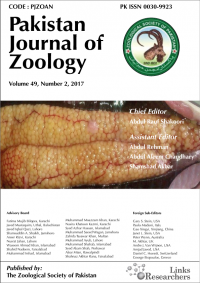Improved Growth Performance, Innate Immune Response, and Gut Microbes by Dietary Inclusion of Polyphenol Rich Agricultural Waste in Hybrid Tilapias
Improved Growth Performance, Innate Immune Response, and Gut Microbes by Dietary Inclusion of Polyphenol Rich Agricultural Waste in Hybrid Tilapias
Aulia Kanwal1, Rehana Kausar2, Muhammad Asif Gondal1* and Chi Chen3
ABSTRACT
Pathogen and stress-related morbidities are the main challenges in tilapia farming. Improving the immune health is an effective approach to protect tilapia against these pathogens. Phenolic content and antioxidant activity of rice husk (RH), sugarcane bagasse (SB), and corn cob (CC) evaluated by Folin-Ciocalteau assay and DPPH assay revealed high total phenolic content and antioxidant activity in RH compared to CC and SB. LCMS analysis of RH, SB, and CC exhibited the presence of hydroxybenzoic acid and hydroxycinnamic acid in agricultural waste samples. Effects of RH, SB, and CC on growth performance, gut microbial flora, innate immunity, and hematology of hybrid red tilapia (Oreochromis aureus X Oreochromis mossambicus) were evaluated in 91 days feeding trial with a test diet supplemented with 10% RH, SB, CC to basal diet (BD) ingredients in optimum conditions of growth. Growth performance data was recorded at an interval of 13 days. At the end of feeding trial, fish gut microflora, skin mucus bactericidal activity, blood serum lysozyme, and bactericidal activity against Shigella sonnei, and hematological parameters were evaluated. Significant difference in growth performance of red tilapia fed with experimental diets was observed. RGR (relative growth rate) was lowest in BD (380.79 ± 46.26) and observed highest in RH (554.01 ± 83.24). Lactobacillus count was increased in all experimental groups. Decrease in Salmonella sp., Shigella sp., and E. coli count was observed in CC. All experimental groups showed enhanced serum bactericidal activity against Shigella sonnei. SB group showed the highest serum bactericidal activity. Skin mucus bactericidal activity was also highest in SB. Least skin mucus bactericidal activity was presented by BD. Results of research work indicated that RH, SB, and CC have bioactive ingredients that positively influenced the growth performance, innate immune response, and hematology of red tilapia. Agricultural by-products are abundant biomass and rich in bioactive and nutraceutical compounds, therefore these are good candidates for maintaining redox balance, health status and growth performance in fish.
To share on other social networks, click on any share button. What are these?










